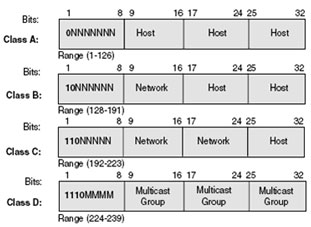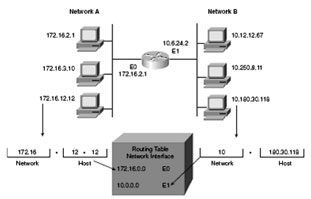| In preparation of our CCNA exam, we want to make sure we cover the various concepts that we could see on our Cisco CCNA exam. So to assist you, below we will discuss TCPIP Addresses.
|
|
| TCP/IP Address Overview |
|
| In a TCP/IP environment, each node must have a unique 32-bit logical IP address. Each IP datagram includes the source and destination IP addresses in the header. |
|
| Host and Network Address |
|
| Each company listed on the Internet is viewed as a single network. This network must be reached before a host within that company can be contacted. A two-part addressing scheme allows the IP address to identify both the network and the host. |
|
|
All the endpoints within a network share a network number. |
|
|
The remaining bits identify each host within that network |
|
|
 |
|
IP Address Classes
|
|
There are five classes of IP: Classes A through E. Classes A, B, and C are the most common. Class A has 8 network bits and 24 host bits. (So there are few Class A networks, but each has many hosts.) Class C addresses allow for many more networks, each with fewer hosts. This scheme was based on the assumption that there would be more small networks than large networks in the world.
Note: The address range for all five classes is shown in the figure. Class D is used for multicast purposes, and Class E addresses are used for research |
|
 |
|
| Class C Address Breakdown |
|
| The example in the figure shows networks A and B connected by a router. Network B has a Class A address (10.0.0.0). The routing table contains entries for network addresses (not hosts within that network). In the example,172.16.0.0 and 10.0.0.0 refer to the wires at each end of the router. Network 10.0.0.0 is a special case of Class A networks. It is typically used in private networks. |
|
 |
|
 |
|
| TCP/IP Address Summary |
|
|
|
In a TCP/IP environment, each end station has a 32-bit logical IP address that has a network and host portion. |
|
|
The address format is known as dotted-decimal notation. The range is 0.0.0.0 to 255.255.255.255 |
|
|
Five address classes are suited to different types of users. |
|
|
Five address classes are suited to different types of users. |
|
|
|
| Continue on to the Implementing Subnet Planning Article |
|
I hope you found this article to be of use and it helps you prepare for your Cisco CCNA certification. Achieving your CCNA certification is much more than just memorizing Cisco exam material. It is having the real world knowledge to configure your Cisco equipment and be able to methodically troubleshoot Cisco issues. So I encourage you to continue in your studies for your CCNA exam certification.




